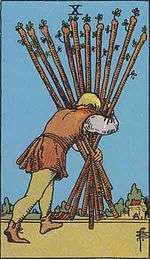Suit of wands

The Suit of Wands or Suit of Batons is used in Latin suited playing cards, such Spanish, Italian and tarot decks. It corresponds to the Suit of Clubs in standard decks.
In tarot, it is part of what is called the "Minor Arcana". Like the other tarot suits, it contains fourteen cards: ace (one), two through ten, page, knight, queen and king.
The suit represents the rural Third Estate (the farmers, laborers, and peasants).
Tarot cards are used throughout much of Europe to play Tarot card games.[1] In English-speaking countries, where the games are largely unknown, Tarot cards came to be utilized primarily for divinatory purposes.[1][2]
Divinatory and occult meanings
In divination, the suit of wands represents the element of fire and gives information relating to the traits of the fire element in astrology. Additionally it represents the peasant or farmer class of feudal society (the Latin suit is commonly called Staves or Rods), and relates to simplicity and to nature, as well as to poverty and submission.
In Aleister Crowley's The Book of Thoth, the suit of wands is associated with the action of the Will and the element of fire.
Cards in the suit of wands
- The Ace of Wands depicts a hand holding a branching wand.
Card images in the Rider-Waite tarot deck
Alternate decks
| Wikimedia Commons has media related to Batons (playing cards). |
In French-language decks, the suit is called Batons ("Staves"). The picture cards are Valet (Page), Chevalier (Horseman or Knight), Reine (Queen), and Roi (King). They were later replaced by the suit of Clubs.
In German and Swiss decks they are represented by Eichelen ("Acorns").
References
- 1 2 Dummett, Michael (1980). The Game of Tarot. Gerald Duckworth and Company Ltd. ISBN 0-7156-1014-7.
- ↑ Huson, Paul, (2004) Mystical Origins of the Tarot: From Ancient Roots to Modern Usage, Vermont: Destiny Books, ISBN 0-89281-190-0 Mystical Origins of the Tarot













